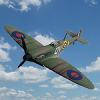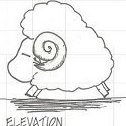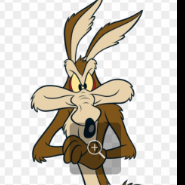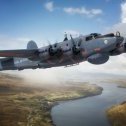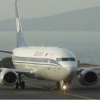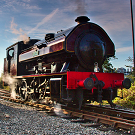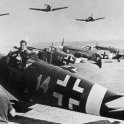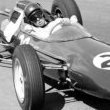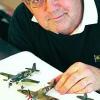Gloster Gauntlet Mk.II ‘Special Markings’ (AZ7868)
1:72 AZ Model by Kovozávody Prostějov
The Gauntlet bears a family resemblance to the Gladiator from the same stable because it preceded it, entering service earlier after an extended development process that would be worthy of a modern defence project. Its development began as early as 1929, but it wasn’t until 1933 that it was given the name Gauntlet, and another two years before it started to enter service with the RAF in small numbers. It was intended as a replacement to the Bulldog, which it outpaced by 50mph thanks to its Bristol Mercury engine, with heavier armament that included two machine guns in troughs in the fuselage sides, firing through the cowling and propeller. Only twenty-four of the initial airframes were made before there were improvements made, which were give the designation Mk.II, resulting in the initial batch being retrospectively named Mk.I.
The Mk.II made up the majority of production, with over 200 manufactured in the UK, plus more built overseas. At its peak there were fourteen squadrons equipped with Gauntlets, but as the storm clouds of war began to gather, it was already outdated. By the time war finally broke out, only one squadron was left in frontline service, the rest having transitioned to more modern fighters such as the Hurricane, which was created by Gloster’s new owners, Hawker, still carrying over some design traits from the Gauntlet through the Gladiator to the Hurricane, particularly in the rear fuselage and tail areas. Fortunately for the Hurricane pilots however, the speed and armament of their new aircraft was much improved and gave them a fighting chance against the enemy. The Gauntlet lingered on as a trainer in the UK and abroad for a while, with a single Mk.II preserved in airworthy condition in Finland, one of its former operators, although the engine has been replaced by something a little more modern for practical reasons.
The Kit
This is a reboxing of a 2008 tooling from AZ that has been re-released with new decals that depict special markings of the Gauntlet in RAF and Finnish service. It arrives in a small end-opening box with a painting of a Gauntlet over a battlefield engaging with a Soviet i16 on the front, and profiles for the decal options on the rear of the box. Inside are three sprues of grey styrene, a decal sheet, a small sheet of clear acrylic with two windscreens printed on it, plus the instruction booklet that is printed on a folded sheet of A4, with a series of rigging profiles on the rearmost page. Detail is good, with just a wisp of flash here and there, and a good representation of the fabric covered framework over the majority of the airframe.
Construction begins with the simple cockpit that is based on a well-detailed flat section of floor, onto which the seat, control column and rudder pedals are fixed, applying four-point decal seatbelts to the pilot’s position for a little extra detail. There is cockpit sidewall detail moulded into the insides of the fuselage halves, and once these and the cockpit are painted and weathered, the fuselage halves can be joined together, adding a two-part instrument panel at the front of the cockpit cut-out. The engine is supplied as a single part with nine cylinders arranged around the core, which is surrounded by a three-part cowling due to the teardrop fairings around the perimeter, finishing the cowling off with a separate lip at the front. The tail fin is moulded into the fuselage halves, adding the individual elevator fins to the sides in small slots, and a tail-wheel with moulded-in strut underneath. The lower wing is a single part that is inserted into a slot under the fuselage, and once the seams have been dealt with, the landing gear can be built, made from two triangular struts that are linked by the axle that has wheels mounted on each end, positioning the assembly on the underside of the fuselage using the small recesses that are moulded into the model to locate them accurately.
Four cabane struts are similarly fitted to the fuselage in front of the cockpit using more guide recesses, which supports the upper wing that is also moulded as a single part. Four interplane struts are fitted between the wings, and a scrap diagram gives details of the tensioner rods that are suspended in the rigging, which is dealt with over the page. A pair of exhausts are mounted under the cowling, cutting the windscreen from the acetate sheet and folding it to shape before gluing it to the front of the cockpit, then slotting the two machine gun barrels in the troughs on each side of the fuselage. The final task (if we ignore the rigging for now) is the three-blade propeller, with a moulded-in spinner to the front. Speaking of rigging, there are four diagrams on the rear of the booklet, detailing the location of the wiring, which should assist with the process along with the box art for a three-quarter view.
Markings
There are three options on the decal sheet, two RAF, and one in Finnish service, which comes with the reversed Swastikas they used at the time, confusing the uninitiated for many years. The British subjects are away from the usual silver dope, including desert and night fighter schemes From the box you can build one of the following:
The decals are printed using a digital process and have good registration, sharpness, and colour density, with a thin gloss carrier film cut loosely around the printed areas. This means that the carrier film on their decals can be coaxed away from the printed part of the decal after they have been applied, effectively rendering them carrier film free, making the completed decals much thinner and more realistic, and obviating the need to apply successive coats of clear varnish to hide the edges of the carrier film. It’s a great step further in realism from my point of view, and saves a good quantity of precious modelling time into the bargain.
Conclusion
The Gauntlet was a well-used interwar fighter that in its day was an impressive improvement over those that it replaced, but was soon to be left in the wake of the next generation of fighters due to the speed of development at the time. The kit depicts its fabric covering well, with a detailed cockpit, and it comes with some interesting decal options.
Highly recommended.
Review sample courtesy of

